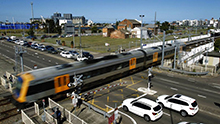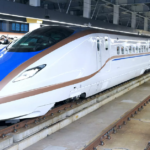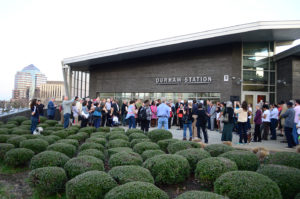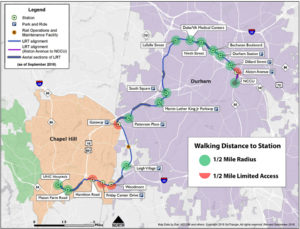Does DOLRT Rest on Sound Assumptions?
Ridership Numbers
GoTriangle estimates 8 million train riders a year. Is this number a plausible estimate?
GoTriangle estimates that each year 8 million people will ride the one train line that is currently being planned. This estimate is absurd according to economist Lutz Hendrichs. There is no light rail system in the United States that attracts this many riders in such a small city.
According to FTA ridership statistics for 2017, there are 35 U.S. cities with light rail systems. Of these, 12 are small enough that they do not need to report data to the FTA. The following is based on the 23 systems that do report ridership figures.
Point 1: All U.S. cities with light rail are much larger than Durham/Chapel Hill
- The median population among cities that report ridership data is 2.4 million. This is 7.3 times larger than the population of Durham/Chapel Hill (population 330,000).
- The smallest city that reports light rail ridership is Buffalo, NY with a population of 940,000 and 4.7 million riders. This is about 3 times larger than Durham/Chapel Hill, but still generates only 58% of the number of riders GoTriangle predicts for Durham/Chapel Hill.
Point 2: GoTriangle’s ridership predictions are unrealistic relative to area population
- GoTriangle predicts 8 million riders per year for a service area of 330,000 persons. This works out to 24 riders per person.
- The median ratio of annual ridership per person for the 23 systems that report ridership statistics is 5.6; less than one quarter of GoTriangle’s prediction.
- NO light rail system in the United States, no matter how dense, achieves 24 annual riders per person.
- Portland (OR-WA) is the system with the highest number of riders per person: 21.4. This is an outlier and likely results from the fact that people commute to Seattle, which is not included in the service area population.
- The second highest number is attained by San Francisco / Oakland (15 riders per person). In other words, GoTriangle predicts a single track connecting Durham with Chapel Hill will produce more riders per persons than San Francisco / Oaklands entire light rail system.
- Charlotte, NC is an obvious comparison: it achieves 3.8 riders per person (4.8m riders out of a population of 1.25 million). This is a plausible estimate for a single rail line. It implies annual ridership for Durham/Chapel Hill of 1.1 million (about 1/7th of GoTriangle’s projection).
- The northern part of 15/501, the section leading into downtown Durham past the split from 15/501 Business, carries about 15,000 riders a day in 2015. GoTriangle’s ridership numbers imply that more than all of these drivers will switch to light rail. Alternatively, it could be that most light rail riders will not actually travel to/from Durham (even though the density of rail stations will be highest there).
Point 3: GoTriangle’s ridership predictions are absurdly high relative to demand for public transit
- All of Durham’s bus lines combined transport 6.3 million riders per year. This is again based on FTA ridership statistics for 2017.
- GoTriangle predicts that a single rail line with transport 1.7 million more riders than all bus lines combined.
- For comparison: The median ratio of light rail to bus annual ridership in the FTA database is 0.32.
- For Charlotte, NC, the ratio is 0.26 (rail transports about 1/4 of the passengers that travel by bus). This would seem like a reasonable expectation for DOLRT, which will feature only a single rail line.
- If the Charlotte ratio holds for DOLRT, we would expect 1.7 million annual riders (less than 1/4 of GoTriangle’s prediction).
Conclusions
There are two conclusions which can be drawn from this comparison:
- The Durham/Chapel Hill area is too small to support a light rail system. No other U.S. city this small has light rail. For light rail to be economically viable, it would have to connect Raleigh to surrounding cities (Cary, Apex).
- GoTriangle’s ridership estimates are pure fantasy numbers that bear no plausible relationship to reality.
Notes on DOLRT Ridership – Lutz Hendricks PHD Economics
Alternatives to light rail technology. Fixed Guideway trains could be obsolete by the time the DOLRT is built. What are the alternatives to light rail?
Clearly, transportation has to move away from cars carrying one or two persons each. Fortunately, alternatives are coming online as I am writing this. Several cities are experimenting with self-driving van services. In contrast to rail, these will solve the “last mile problem.” Instead of discharging passengers at a handful of train stations, vans drop off passengers where they actually need to go.
By the time the planned DOLRT would come online (2028, if everything goes according to plan), it will be technologically obsolete.
You can help by signing the petition asking the Orange County commissioners to finally cap the local cost.











Follow Us